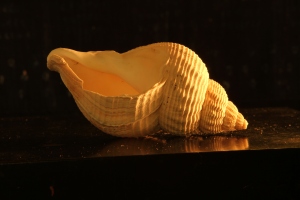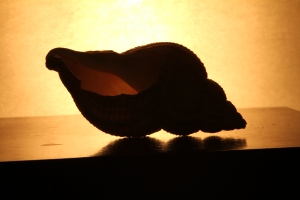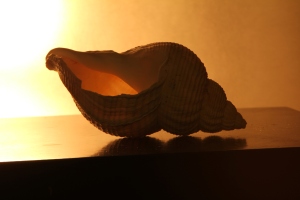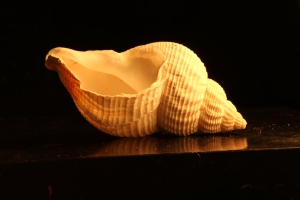LIGHT Exercise – The Lighting Angle
For this Exercise my lounge diner had to be converted into a makeshift studio set up again as the aim was to light an object with artificial diffused light from a variety of angles including the back. I chose to photograph a sea shell as it had a rounded shape with both surface and structural variation as well as being partially translucent which I thought would add to the interest of the Exercise. I supported a small halogen spotlight on a spare tripod and positioned the shell on a low table with a dark cloth background to make it stand out.
I used a 24 – 70mm f 2.8 lens on my Canon 7D which was mounted on a tripod and fired with a cable release, and I held a diffuser that I had made out of white packing material stretched over an old picture frame between the light source and the image for each shot. Early attempts suggested that there was too much ambient light bouncing around the room from the windows which was affecting the final images so I closed the curtains to try to reduce this effect. In order to reduce overexposure which was occurring in some images I stopped the aperture down by 1 stop for all shots.
12 shots were taken with the diffused light source at different positions in relation to the subject, as follows: –
1. With the light at the same level as the subject :- a). From the right side; b). From the front; c). From off to the right behind; d). From directly behind; and e). From off to the left behind.
2. With the light at 45 degrees above the subject : – a). From the right side; b). From the front; c). From off to the right behind; and d). From directly behind.
3. With the light above the subject : – a). From directly above; b). From the front from above; and c). From behind from above.
—– o0o —–
1. LIGHT AT SAME LEVEL AS SUBJECT
a. From right side

b. From front

c. From right side behind

d. From directly behind

e. From left side behind

—– o0o —–
2. LIGHT FROM 45 DEGREES ABOVE
a). From right side

b). From front

c). From right side behind

d). From directly behind

—– o0o —–
3. WITH LIGHT ABOVE SUBJECT
a). From directly above

b). From above from the front

c). From above from behind

—– o0o —–
DISCUSSION
As would be expected there was considerable variation between the different shots and some were more striking and attractive than others. I will look at the different groupings in detail to consider the differences between them and to comment on their visual appeal.
Shots taken with the light from the front – Images 1(b), 2(b) and 3(b)
For me, the shot taken from the front with the light at the same level as the subject, Image 1(b), is the least interesting in that it is rather flat and uninteresting with little contrast or variation in tone across the subject. It does demonstrate the two dimensional shape of the shell against the dark background without much in the way of detail and contrast to distract. Much surface detail is lost particularly towards the middle of the image as a result of lack of contrast and grazing lateral light rather than over-exposure. It is interesting to compare this with images 1(a) and 1(b) where there is lateral fall of light and where considerable surface and structural detail is apparent. The frontal lighting is also reflected from the front face of the supporting base which distracts attention from the subject.
In image 2(b) where the lighting is from 45 degrees above the subject, the light grazes the lower part of the shell giving some definition of detail but detail is lost in the upper section where the light hits it straight on. As would be expected the shadow beneath the shell in image 2(b) is marginally weaker compared with that in image 2(a) where the light comes from the right side but there is not a lot in it so some light must be leaking round in both cases. Interestingly, whereas the overall detail and contrast is considerably greater in image 2(a), the shadow and contrast in the surface detail in the lower section of image 2(b) is much greater making it look almost craggy!
In images 3(a) and 3(b), where the light is coming from almost directly above, there is shadow in the lower areas of the subject but, as one would expect, the shadow is deeper and more extensive in 3(a) where the light source is directly above when compared with 3(b) where the light direction is slightly from the front. It is possible that there is some reflection of light from the slightly shiny surface of the base on which the shell sits which could reduce the depth of the shadow in both cases. Also in both cases the light from above shines through the shell opening and lights up the shell wall showing the thicker and thinner banded nature of the structure in an attractive way. More light passes through the shell wall when the light source is directly above as one would expect. In both cases much detail is lost in the upper surface of the shell where the light strikes it directly although there is attractive soft detailing of the interior of the shell where the light is more refracted.
Shots taken with the light from the side – Images 1 (a), 1 (c) 1 (e), 2 (a), and 2 (c).
Level light from the side provides glancing lateral light which creates shadows where it hits irregularities and overall contrast across the image. This is clearly demonstrated when one compares image 1 (a) and image 1 (b) which is lit from in front.
The effect becomes more complicated when, as in image 2 (a), the subject is lit from the side but with the light source at a higher level so that the direction of the light is partially lateral and partially dorso-ventral. In this case, the definition of surface and structural irregularities is picked out by shadow across almost the whole object whereas in image 2 (b) where the light source is again at a higher level but at the front, where the dorso-ventral light strikes the lower half obliquely creating shadow and definition, there is little definition and contrast in the upper areas where the light strikes directly.
Where the light source is off to the right side but behind the subject the effect is different. In image 1 (c) where the light source is on the same level as the subject, the only brightly lit part of the shell is the upper edge while most of the rest is in shadow or is lit only by reflected light or light actually passing through the shell wall. The interior of the shell is attractively lit by light transmitted through the shell and there is considerable detail visible in the exterior of the shell presumably from reflected light. Where the light source is from the left as in image 1 (e) the effect is very different again. Here most of the shell is in silhouette, the only light coming through the wall. Unlike in image 1 (c) very little manages to get round to light any other areas and I suspect that this is because the light source is further behind the subject in this case.
Where the light source is raised to 45 degrees on the right side as in image 2 (c), the light illuminates the top of the shell in a most attractive way whilst also shining through the shell to illuminate the interior. The contrast creates a very pleasing image. The higher angle of the light source also illuminates the base on which the shell stands adding additional interest and creating a dark reflection below that seems to be supporting the shell. This is one of my favourite of all these images.
Shots taken with the light behind the subject – Images 1 (d), 2 (d) and 3 (c).
As would be expected, image 1 (d) with the light source directly behind and on the same level as the subject is a silhouette with no light leaking round to illuminate the front face at all except where some is shining through the rear wall of the shell to light the interior. This is by far the darkest and most contrasty image of all this set and shows the general outline shape more clearly than any of the other images.
Although again lit from the back, image 2 (d) is very different because the light source was at a higher level and some light was able to leak round to the front face at the top and into the hollow cavity of the shell. As with all the shots taken from behind the subject, the angle of the light hitting the top of the supporting base is such that it is reflected towards the camera giving a different feel to the image than with light sources from the side, the front or directly above.
With the light above the subject but slightly behind, the shell is fairly evenly lit throughout much of its surface similar to the shot taken with the light from directly above suggesting that significant amount of light was bleeding round the subject or being reflected from the base.
.
———- o0o ———-